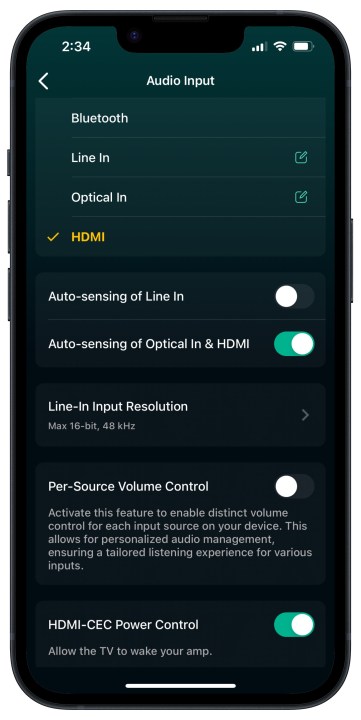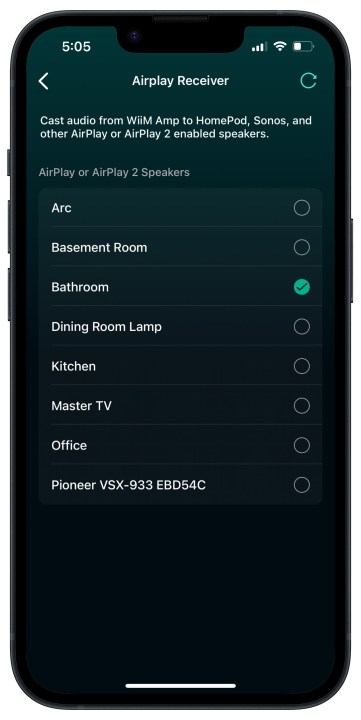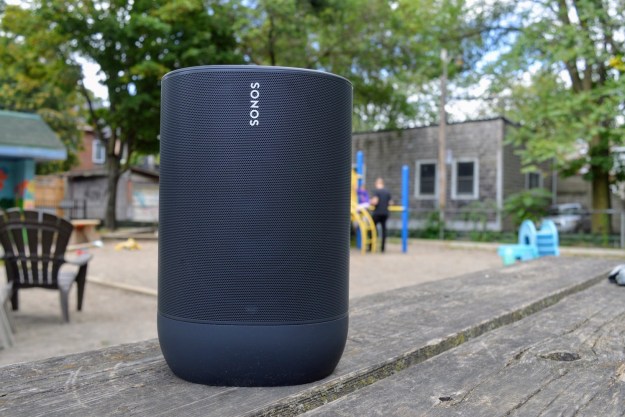
“Look out, Sonos. The Wiim Amp is an unbeatable integrated amp/network media streamer value.”
- Very affordable
- Sleek, minimal design
- Easy setup
- Excellent app support
- Vibrant, powerful, and engaging sound
- 2-way Bluetooth and AirPlay
- Chromecast built-in
- No track controls on unit
- No IR remote support or headphone output
- No Dolby Digital/Atmos or DTS
The $299 Wiim Amp is an audio Swiss army knife. It can act as a multisource integrated amplifier, a wireless streaming music player, an Amazon Alexa smart speaker, and even a companion for your TV. Attach a decent set of passive speakers (and possibly a subwoofer) and you’ve got a sleek and compact sound system that pretty much does it all.
I’ve just wrapped up a three-week evaluation of it, and I couldn’t be more impressed. Even if you already have an integrated amp or receiver, you may want to consider swapping it for the Wiim Amp. Here’s why.
Is it a Sonos clone?

Let’s address one very important thing right off the bat. Though Wiim, which is owned by LinkPlay, is still a newcomer to the home audio scene, it has been getting a ton of attention thanks to the company’s strategy of taking the best features of Sonos’ devices and selling them for far less.
My first experience with this was the Wiim Pro, a network streaming music player that you could argue is a $149 Sonos Port clone.
It’s not just the hardware — on some of its screens, Wiim’s mobile app is a dead ringer for the Sonos app.
But while the Wiim Pro made a highly effective argument that you don’t need to spend Sonos Port money to get Sonos Port features, when it comes to the Wiim Amp and its closest Sonos competitor, the $699 Sonos Amp, it’s not quite apples to apples. I’ll discuss the differences throughout this review.
What’s in the box?
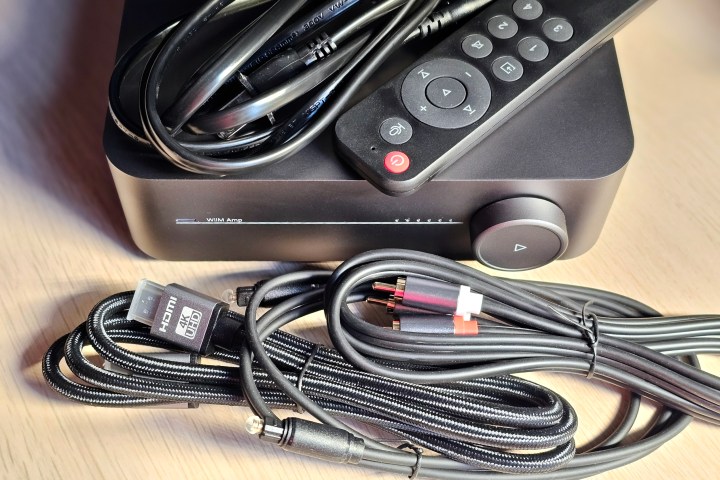
Wiim ships the Amp with a power cord, an HDMI cable, an optical cable, a stereo RCA cable, and a Bluetooth voice remote. Be warned though: Wiim has bucked the decades-long trend of including batteries, so you’ll have to supply your own set of AAA cells.
The only other things you’ll need (assuming you already have speaker cable to go with your passive speakers) are an Ethernet cable (this is optional — most folks will use the built-in Wi-Fi) and an RCA coaxial cable if you intend on connecting a powered subwoofer.
Designed in Cupertino?

Like many other tech companies, Wiim has taken its design inspiration for the Amp from Apple. The device is wrapped in an aluminum skin, in your choice of Apple’s two favorite colors: silver or space gray.
The result is a component that looks terrific — our space gray evaluation unit would complement even the most elegant and contemporary decor.
It’s a smart decision on Wiim’s part. As much as I like the Wiim Pro, its black plastic enclosure looks and feels a little cheap. It’s not bad by any means, but it’s nothing like the Amp’s premium aesthetics. From a functionality standpoint, there’s no reason why you can’t tuck the Wiim Amp away in a console or cupboard — all of its functions can be accessed via the Wiim app or the included Bluetooth remote. But with looks like this, it deserves to be visible.
The integrated volume/play/pause control on the front panel is the one design choice that feels a little less thoughtful.
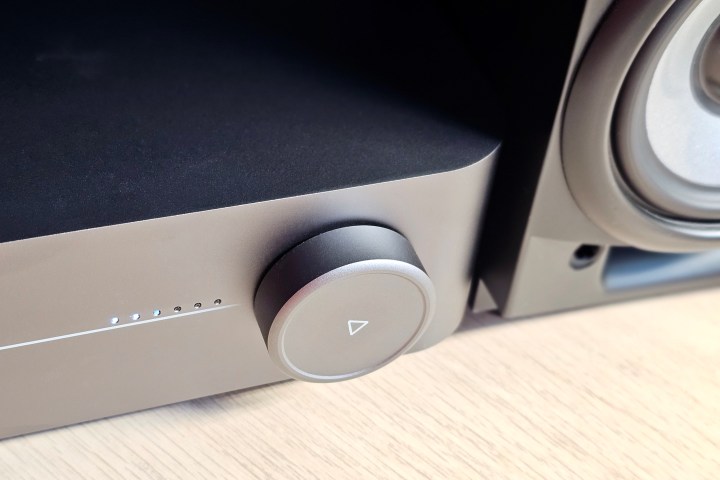
It’s a great size and shape, and the rotating ring has pleasingly indexed notched clicks in its spin. But the central button spins too, causing the “play” triangle to point in a variety of directions as you change the volume, instead of remaining in the normal right-pointing orientation.
Admittedly, I’m nitpicking, but my eye keeps wanting to straighten it out — which it refuses to let me do.
One critique that feels less nitpicky: there’s no way to track-skip forward or backward using the central button. It’s a strange omission since the Sonos Amp gives you this capability.
Right beside the big knob is a six-LED volume scale, a nice touch on a product that effectively replaces a receiver or amp, and it’s something the Sonos Amp lacks. You can leave it lit while the power is on, or it can fade to black a few seconds after your last volume change.
Finally, a single LED on the left side acts as a power/mode indicator. Depending on what it’s trying to tell you, it will glow or flash white, green, or red to indicate source, wireless connection states, or if something’s gone amiss.
One small caveat for home theater people: The Wiim Amp doesn’t have an infrared receiver. So if you decide to connect it to your TV via analog or optical instead of HDMI, you’ll need to keep the included remote (or the app) handy for volume and muting since your TV’s remote won’t be able to control it.
Ports galore
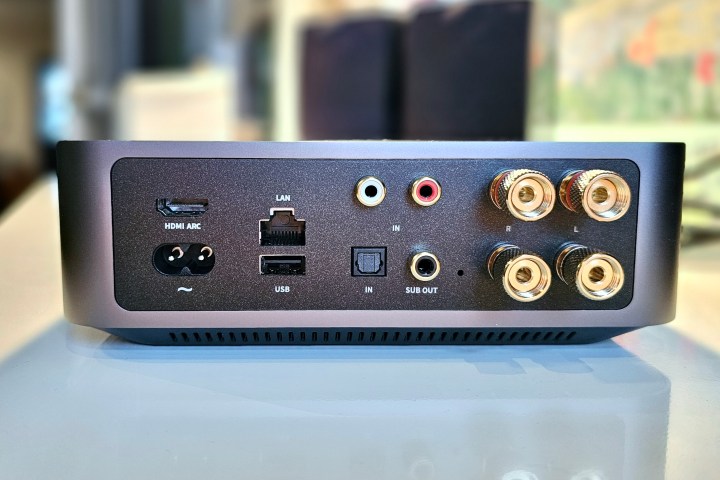
Around the back are the physical inputs and outputs. And they are plentiful: HDMI ARC, optical in, analog line-in, USB-A, and Ethernet. I would have also welcomed a digital USB input for PC audio, but alas, no such luck. (The USB-A port is strictly for access to storage devices.) Wireless inputs are just as generous: Bluetooth, Apple AirPlay, Chromecast, and Amazon Alexa Cast. In fact, I was able to mostly get around the lack of a PC input by sending my Mac’s audio output to the Wiim Amp using AirPlay.
The outputs are more restrictive, limited to a set of stereo speaker 5-way binding posts and a subwoofer out. The one big omission here is the lack of a headphone output.
As with the Sonos Amp, you can’t use the Wiim Amp as a networked music streamer for existing amps/receivers. If you want to do that, Wiim’s Mini, Wiim Pro, and Wiim Pro Plus are better choices.
The Amp does have wireless outputs, however. It can be used as a source for both Bluetooth and AirPlay streaming. This gives the Amp the intriguing ability to send audio to other wireless speakers and headphones.
The optical and HDMI ARC input require little thought — just attach a TV, CD player, Blu-ray player, or any other compatible digital source. You can use a turntable, too (with the analog line-in jacks), but keep in mind that your turntable must have a built-in phono preamp. Otherwise, you’ll need an external phono preamp. It’s also worth noting that the Amp doesn’t offer a direct analog connection between input and amplification. All analog audio is converted to digital before being converted back to analog.
Like most receivers with an HDMI ARC input, the Wiim Amp can take commands (including power on/off) from your TV if the TV is configured with HDMI CEC (Consumer Electronics Control). If this is your main listening scenario, you may never need to reach for the Amp’s remote.
Installation and setup
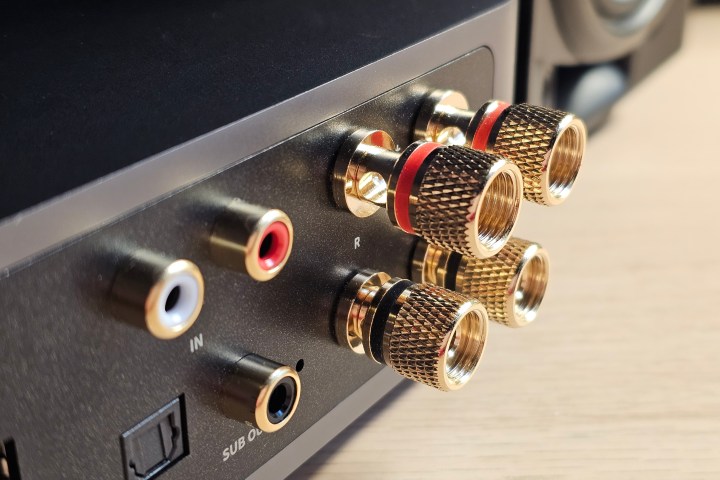
Word to the wise: before you plug the Wiim Amp into power, you’re going to want to connect your speakers. That’s good advice in general, but with the Wiim Amp, you should consider it gospel. Unlike most integrated amps or receivers with physical power buttons, plugging in the Wiim is the same as turning it on.
And while the likelihood of disaster is small, it’s not worth risking damage to your speakers or the Amp by causing an accidental short in the wiring.
How you connect your speakers is up to you. The 5-way binding posts accept almost any method including banana plugs and bare wires. Since it’s possible (though not an official feature) to run two sets of 8-ohm speakers (4 speakers in total), it’s nice to be able to run one set via banana plugs and another set as bare wire — the Sonos Amp can only handle one of these connections at a time.
Once you’re powered up, the free Wiim app (iOS/Android/macOS/Windows) walks you through the remainder of the setup process, which takes no time at all. It automatically grabs your network settings from your phone, offers you the ability to rename the Amp from its default network ID, pairs with the included Bluetooth remote, and finishes by walking you through the optional AirPlay, Chromecast, and Amazon Alexa setups.
At this point, you’re ready to rock. You can add your streaming service subscriptions to avail yourself of the app’s impressive feature set (including my favorite Sonos feature, universal search), or you can treat the app as just a settings interface for the Wiim Amp and do all of your streaming from third-party apps thanks to AirPlay, Chromecast, and Bluetooth.
Impressive sound quality

Considering the Wiim Amp’s power specs (60 watts per channel at 8 ohms or 120 watts at 4 ohms), it can theoretically drive a wide variety of passive speakers — even low-impedance models. Its sweet spot, however, is a set of 8-ohm bookshelf speakers.
Given a choice, I’d have loved to put the Amp through its paces with a set of KEF Q150 or Bowers & Wilkins 607 S3 speakers. But, sadly, I was working with what I had on hand.
For my tests, I used two setups. First, I used a single pair of Energy CB5 bookshelf speakers to get a sense of the Wiim Amp’s overall performance. Then I put the Amp side by side with a Sonos Amp and connected them to matching sets of Energy Take 5.2HB1 satellite speakers. These are not the speakers I’d recommend for either Amp, but my goal was to compare apples to apples by rapidly switching back-and-forth between devices.
In both cases, I listened with and without an Energy S8.2 wired subwoofer.

If there are any performance issues with the Wiim Amp, these tests did not reveal them. Using multiple sources like Tidal, Amazon Music, and Qobuz from the Wiim app, plus Apple Music via AirPlay, I threw a huge range of genres at it, from jazz to rap. I listened to all of my favorite test tracks, like Tracy Chapman’s Fast Car and Billie Eilish’s bad guy, and the Wiim Amp held its own.
It’s clear and articulate, and it reminded me why my Energy speakers were praised for their sound when I bought them almost 22 years ago. I played it as loud as I dared (about 85%) and couldn’t detect any distortion.
TV sound through the HDMI port was just as enjoyable, without any perceptible lag. While it’s true that the Wiim can’t process Dolby Digital 5.1, DTS, or Dolby Atmos signals (you’ll need to set your TV to output PCM), its 2.1 presentation sounds surprisingly immersive, and dialogue clarity proved to be an unexpected highlight.
From an EQ perspective, the factory tuning felt a little harsh in the high frequencies — especially when I compared it to the Sonos Amp’s much warmer bias. But if you know your way around an equalizer (with your choice of graphic or parametric interfaces), the enormous number of available settings should get things dialed in just the way you want them. When you’re happy, you can save as many settings as you need. And if that’s way too much fuss? I’m guessing the generous selection of EQ presets will get you most of the way there.
That’s something the Sonos Amp doesn’t offer. Its only tone controls are separate bass and treble sliders.

As you might expect, connecting the wired sub vastly improved the sound. Bookshelf speakers aren’t renowned for their low end, and the satellites definitely needed the extra help. Curiously, the Sonos Amp is somewhat restrictive in terms of selectable crossover frequencies — with a range of 50Hz to 110Hz — while the Wiim gives you access to an enormous range of 30Hz to 250Hz. For most speakers, Sonos’ range will suffice, but my little Energy satellites are happiest when they can pass along frequencies under 120Hz — just a hair outside of the Sonos Amp’s range.
Where Sonos will inevitably prove more versatile is its power. Rated at 125 watts per channel at 8 ohms and 250 watts at 4 ohms, you’ll be able to exploit your speakers’ capabilities more effectively. You’ll also have more range when dealing with the uneven levels of different sources. Playing The Lord of The Rings: The Rings of Power from the built-in Amazon Prime app on my LG TV, I had to set the Wiim’s output at almost 90% to achieve the same volume that the Sonos delivered at 60%.
Though neither Wiim nor Sonos recommends larger-than-bookshelf-size speakers, the Sonos Amp will be the better choice if you’re determined to try it.
The Wiim app and streaming options
It’s hard to beat Sonos when it comes to the power and functionality of its software. In the world of multiroom wireless audio, it’s still the leader. And yet, Wiim has done such a good job of reproducing Sonos’ key strengths that you have to look hard to find the areas where Sonos remains ahead.
For major activities like finding and playing music, controlling playback, grouping and ungrouping devices throughout your home, and saving your favorite tracks, albums, or playlists for easy access, Wiim and Sonos are neck and neck. Wiim has even built its own universal search, letting you see matching music from your subscription services and your personal music catalog in a single set of results — a skill that had been a Sonos exclusive for years.
But if you’re extremely picky about maximizing sound quality, Wiim’s platform is technically superior. It can decode lossless digital audio at up to 24-bit/192kHz, and it’s compatible with the MQA format. It’s not that Sonos’ 24-bit/48kHz maximum is bad. It’s just that if you have access to higher sampling rate files — for example, Qobuz, Amazon Music, or Apple Music hi-res audio, (or MQA via Tidal) — it’s reasonable to want a device that lets you hear all of that extra detail — even if most humans probably can’t hear a difference at all. Like Sonos, it works with Roon, but sadly, DSD fans will have to look elsewhere — it’s the one hi-res format Wiim doesn’t support.
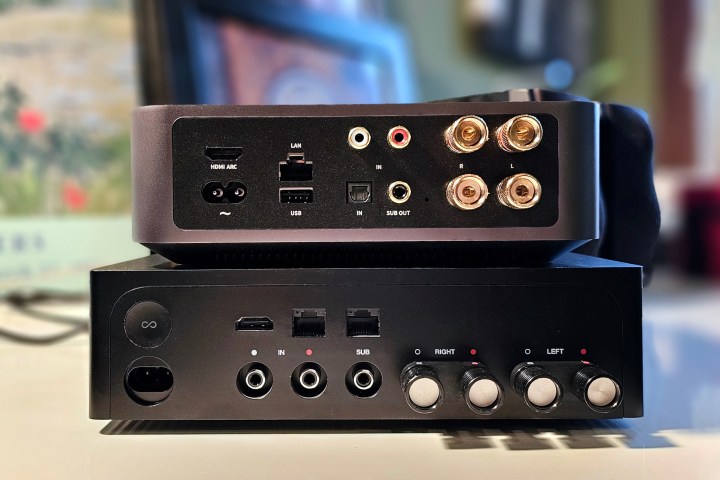
Sonos still has an edge when it comes to the number of streaming services it supports natively inside its app. Its catalog of compatible services is massive. Even tiny services for niche audiences like Familystream, which caters to listeners of reformed Christian music, can be integrated into the Sonos app.
But its most important inclusions are Apple Music, Spotify, and YouTube Music — three major services you won’t find within the Wiim app. So far, Sonos is the only company other than Apple itself that offers direct Apple Music integration into its wireless audio products.
The absence of those three services notwithstanding, Wiim has most of the music services people want, including Amazon Music, Deezer, Napster, Pandora, Qobuz, Radio Paradise, Tidal, TuneIn, and iHeartRadio.
And when it comes to Apple Music, Spotify, and YouTube Music, there are still plenty of ways to access them outside of the Wiim app. All three can be streamed to the Wiim Amp over Bluetooth, AirPlay, or Chromecast (depending on your phone’s options), and the Amp is also Spotify Connect-compatible for direct streaming from within the Spotify app.
Speaking of streaming over wireless connections, the Wiim Amp is astonishingly flexible. Normally, protocols like Bluetooth and AirPlay tend to be one-way. We use them to stream from our phones to our wireless speakers. The Wiim Amp, however, can act as both a receiver and a sender, which opens up all kinds of possibilities.
For instance, if you own any AirPlay-compatible speakers (including Sonos speakers made since 2017), you can output the Amp’s audio to them — on a speaker-by-speaker basis. That’s a clever way for Android users to get around the absence of AirPlay on their phones. It’s also a handy way to send the audio from the Amp’s three inputs (optical, line-in, and HDMI) to other speakers in your home.
But perhaps more relevant is the ability to pair a set of Bluetooth headphones. If your TV (or streaming video player) doesn’t support this feature, it’s a good way to do private listening when you don’t want to disturb the rest of your household with your 2 a.m. John Wick marathon.
The one caveat: You can set the Wiim Amp to output sound wirelessly or via the speaker terminals, but not both simultaneously.
For all its strengths, this is one area where the Sonos Amp feels decidedly limited. The only way to stream to it wirelessly is via the Sonos app or Apple AirPlay, and it has no streaming outputs (except to other Sonos products).
Voice remote, other options, and final thoughts

By now, I’m sure you’ve figured out that I’m a fan of the Wiim Amp. Still, there’s more to be said in favor of this all-in-one streaming box. Take the included Bluetooth remote, for instance. It’s easy to overlook because most folks will use the Wiim app to interact with the Amp.
And yet, it not only turns the Amp into a full-fledged Amazon Alexa smart speaker, but it also gives everyone in the house (and visitors too) an easy, familiar, and app-free way to control important functions like volume, muting, playback, and source selection, including access to the first four of 12 available presets. That’s a lot of extra value that the Sonos Amp can’t match.
The Sonos Amp is the obvious comparison to the Wiim Amp, but it’s not the only competition. If you’re curious about your other choices, these are the main contenders.
Denon HEOS Amplifier HS2 ($499)
- Class D, 70 watts per channel (8 ohms)
- Supports DSD
- No HDMI input
- No AirPlay, Bluetooth, or Chromecast
- No remote control
- HEOS app isn’t as full-featured for streaming
Bose Music Amplifier ($699)
- Class D, 125 watts per channel (8 ohms)
- AirPlay, Bluetooth, and Chromecast
- Connects to Bose headphones via Bluetooth
- No remote control
- No HDMI input
- Only compatible with Bose wired subwoofers
- Limited in-app music services
- Limited support for hi-res audio formats
- No external controls
Bluesound Powernode ($949)
- Class D, 80 watts per channel (8 ohms)
- HDMI ARC/eARC
- Wired and wireless headphone connections
- Two versatile optical/analog combo inputs
- Full touch controls
- 2-way Bluetooth aptX HD, Apple AirPlay
- IR-compatible
- Full hi-res support including MQA (no DSD)
- Very good app control with plenty of compatible music services
- No Chromecast
As you can see, they’re all more expensive than the Wiim Amp, and that extra investment doesn’t always mean more or better features and performance. For its price, the Wiim Amp provides an unbeatable value and demonstrates that LinkPlay’s success with its first Wiim products wasn’t just a fluke.
I’m seriously looking forward to seeing the brand’s evolution into wireless speakers. It hasn’t announced anything on that front, but if its current trajectory is anything to go by, it’s the next logical step. When that happens, it will be fascinating to see if Wiim can once again offer a Sonos-like experience for less.
Editors' Recommendations
- Best wireless speakers for 2024: Sonos, Apple, KEF, and more
- HEOS app refresh adds some of Sonos’ best features
- The best Bluetooth speakers for 2023: Marshall, Sonos, JBL, and more
- Sonos’ new Era 100 and Era 300 wireless speakers go all-in on spatial audio and Bluetooth
- New leak hints at Sonos’ future: Bluetooth, spatial audio, and lots more home theater











